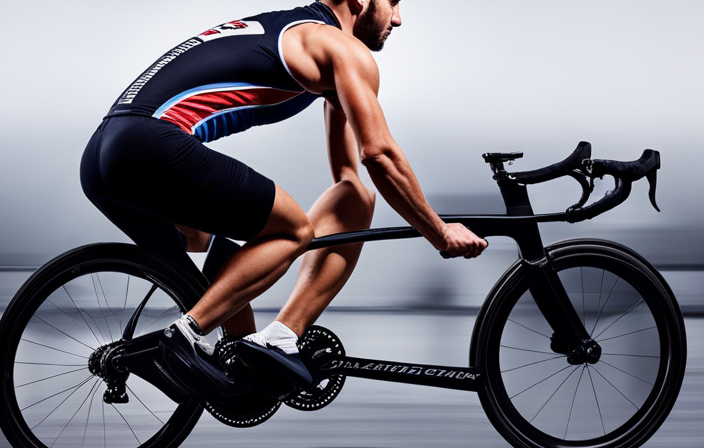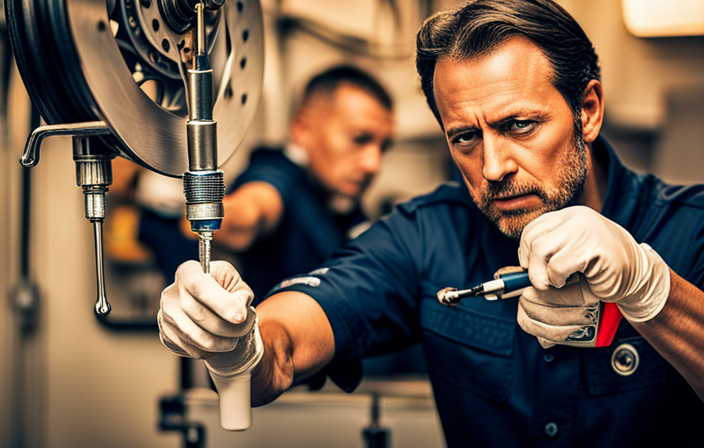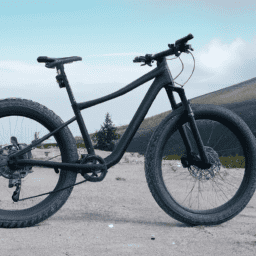Riding a bike vigorously activates multiple muscles, making it an excellent workout for overall fitness. By pedaling, muscles in the lower body like the quadriceps, hamstrings, and glutes are engaged to produce force. At the same time, core muscles such as the abdominals and obliques stabilize the body, improving balance.
Even the upper body muscles, like the arms and shoulders, assist in steering and maintaining control. With these diverse muscle groups working in harmony, cycling provides a comprehensive and effective workout for both body and mind.
Key Takeaways
- Cycling engages a variety of muscles throughout the body, including the shoulders, deltoids, rotator cuff, upper back, leg muscles (quadriceps, hamstrings, calves), and core muscles (abdominals, lower back).
- Pedaling requires coordination between the legs, arms, and core muscles, which helps strengthen coordination skills and improve fine motor skills and hand-eye coordination.
- Cycling has mental health benefits, such as reducing stress levels, improving mood, clearing the mind, alleviating anxiety, and enhancing overall mental well-being.
- Cycling is an effective activity for overall fitness and weight management, as it burns calories, builds lean muscle mass, improves metabolism, and helps achieve physical fitness and weight management goals. Additionally, it is a low-impact activity suitable for injury prevention and rehabilitation, as it minimizes stress on joints, aids in the rehabilitation of knee injuries, and enhances muscle strength and joint stability.
Lower Body Muscles
Cycling primarily targets the lower body muscles, such as the quadriceps, hamstrings, and glutes. These muscles are responsible for generating power and propelling the bicycle forward.
When pedaling, the quadriceps, located in the front of the thigh, contract to extend the knee. Meanwhile, the hamstrings, located at the back of the thigh, work to flex the knee. The glutes, or the muscles in the buttocks, also play a significant role in cycling by providing stability and power during each pedal stroke.
In addition to building strength in these muscles, cycling also improves flexibility in the lower body. Regular cycling helps to increase the range of motion in the hips, knees, and ankles.
As we transition into the subsequent section about core muscles, it is important to note that cycling also engages and strengthens the muscles of the core, contributing to overall stability and balance on the bike.
Core Muscles
Engaging the core is essential when cycling. The core muscles play a crucial role in maintaining stability and providing a strong foundation for the lower body during cycling. These muscles, including the abdominals, obliques, and lower back muscles, work together to stabilize the pelvis and transfer power from the legs to the pedals.
Core stability is important for maintaining proper posture and preventing excessive movement or swaying while cycling. Additionally, a strong core can help improve overall cycling performance by increasing power output and reducing the risk of injuries. To enhance core strength and stability, cyclists can incorporate exercises such as planks, Russian twists, and bicycle crunches into their training routine. By focusing on developing strong abdominal muscles, cyclists can improve their cycling efficiency and reduce the strain on their lower back.
Transitioning into the subsequent section about upper body muscles, it is important to also consider the role of these muscles in cycling.
Upper Body Muscles
To strengthen your upper body, focus on exercises that target your chest, shoulders, and arms. These exercises will not only increase your upper body strength but also help you improve your posture and overall balance.
When it comes to upper body strength, the chest muscles (pectoralis major and minor), shoulder muscles (deltoids), and arm muscles (biceps and triceps) are the primary muscles involved. To effectively target these muscles, incorporate exercises like push-ups, chest presses, shoulder presses, and bicep curls into your workout routine.
Additionally, don’t forget to engage your core muscles to stabilize your upper body during these exercises. Speaking of core muscles, they play a crucial role in maintaining balance and stability during cycling.
Balance and Stability Muscles
Improve your balance and stability by incorporating exercises that target your core muscles. Balance training is essential for cyclists as it helps maintain proper body alignment and control while riding.
By engaging the core muscles, such as the abdominals, obliques, and lower back, you can enhance proprioception, which is the body’s ability to sense its position in space. Proprioception enhancement is crucial for maintaining balance and stability on a bicycle, especially when navigating challenging terrains or making quick turns.
Additionally, a strong core can help prevent injuries by stabilizing the spine and reducing stress on the lower back.
To further enhance your cycling performance, it is important to also focus on endurance and cardiovascular conditioning. By incorporating aerobic exercises, such as cycling or running, you can improve your overall stamina and cardiovascular health, allowing you to ride longer distances without fatigue.
Endurance and Cardiovascular Conditioning
Enhance your cycling performance by incorporating aerobic exercises such as cycling or running to improve your endurance and cardiovascular conditioning. Endurance training is crucial for cyclists as it allows them to ride longer distances without fatiguing. It also improves heart health, increasing the heart’s ability to pump blood efficiently.
To understand the impact of endurance training on the cardiovascular system, let’s take a look at the table below:
| Exercise | Duration | Intensity |
|---|---|---|
| Cycling | 60 mins | Moderate |
| Running | 30 mins | Vigorous |
| Swimming | 45 mins | Moderate |
| Rowing | 20 mins | Vigorous |
Incorporating these exercises into your routine will not only strengthen your heart but also improve your overall performance on the bike. By training your cardiovascular system, you’ll be able to ride longer and recover faster.
Now, let’s transition to the next section where we’ll discuss the importance of postural muscles in cycling.
Postural Muscles
The postural muscles, including the upper back, neck, and shoulders, play a crucial role in maintaining proper posture and stability during various activities. These muscles work together to support the spine, keep the head aligned, and provide a stable base for movements.
Strengthening these muscles through targeted exercises can help prevent postural imbalances and reduce the risk of musculoskeletal injuries.
Upper Back
Cycling strengthens the muscles in your upper back, which is essential for improving posture and relieving tension. The repetitive motion of pedaling engages the muscles in your upper back, including the trapezius, rhomboids, and latissimus dorsi. These muscles work together to stabilize and support your spine, promoting proper alignment and reducing strain on your neck and shoulders.
- Trapezius: This large muscle extends from the base of your skull to your mid-back and is responsible for shoulder movement and stability.
- Rhomboids: These muscles are located between your shoulder blades and help retract and stabilize the scapulae.
- Latissimus dorsi: This broad muscle spans across your back and plays a crucial role in arm movement and posture.
- Erector spinae: These muscles run along your spine and help maintain an upright posture.
By strengthening these muscles through cycling, you can improve your overall posture and reduce tension in your upper back.
This sets the stage for the subsequent section about the impact of cycling on the neck.
Neck
Moving on from discussing the benefits of cycling for the upper back, let’s delve into how cycling can also impact the neck. As a cyclist, I have experienced firsthand how cycling can affect this area of the body. The neck muscles play a crucial role in maintaining stability and proper alignment while cycling. Cycling engages the neck muscles as they constantly work to keep the head in an upright position, allowing for better visibility on the road. Additionally, cycling can help reduce stress in the neck muscles by promoting blood flow and oxygenation. This, in turn, improves flexibility and helps prevent stiffness and discomfort. To illustrate the various muscles involved in the neck during cycling, the following table provides a comprehensive overview:
| Muscle Name | Function |
|---|---|
| Sternocleidomastoid | Rotates and flexes the neck |
| Trapezius | Stabilizes and supports the neck |
| Levator Scapulae | Elevates the scapula and supports neck movement |
| Splenius Capitis | Extends and rotates the neck |
| Scalene | Supports neck movement and aids in respiration |
Moving forward, let’s explore the impact of cycling on the shoulders.
Shoulders
When cycling, your shoulders play a crucial role in maintaining stability and supporting your upper body. Shoulder strength and mobility are essential for proper cycling form and efficiency. Here are five key ways in which cycling works your shoulders:
-
Shoulder stability: Your shoulder muscles work to stabilize your upper body as you grip the handlebars and maintain an upright posture.
-
Deltoid activation: The deltoid muscles, located at the top of your shoulders, are engaged when you steer and maneuver the bicycle.
-
Rotator cuff engagement: Cycling movements activate the rotator cuff muscles, which provide stability to the shoulder joint.
-
Upper back engagement: Cycling also engages the muscles in your upper back, including the trapezius and rhomboids, which help support your posture.
-
Arm and shoulder endurance: The repetitive motion of cycling helps build endurance in your arms and shoulders.
Understanding how cycling engages your shoulder muscles is essential for optimizing your performance and preventing injuries.
Transitioning to the next section, coordination and motor skills, we can explore how these muscles work together to enhance your cycling experience.
Coordination and Motor Skills
Pedaling a bicycle helps improve coordination and motor skills. The act of pedaling requires a coordinated effort between the legs, arms, and core muscles. It is a repetitive movement that requires fine-tuned coordination between the muscles involved. This constant repetition helps to strengthen and develop the coordination skills necessary for other activities.
In addition, pedaling a bicycle also contributes to the development of fine motor skills. The hands and fingers are actively engaged in gripping the handlebars and operating the brakes, which helps to improve dexterity and hand-eye coordination.
Furthermore, research has shown that engaging in coordination exercises, such as cycling, can have positive effects on mental health. Regular physical activity, like cycling, has been linked to reduced symptoms of anxiety and depression. It can also improve cognitive function and boost overall mood.
Therefore, cycling not only benefits our physical well-being but also plays a crucial role in supporting our mental health.
Mental Health Benefits
Now that we have explored the coordination and motor skills involved in cycling, it is important to understand the mental health benefits that this activity offers.
Cycling has been shown to have a positive impact on mental well-being, and it can be a great way to improve overall mental health. Regular cycling has been linked to reduced stress levels, improved mood, and enhanced cognitive function. The release of endorphins during exercise can boost feelings of happiness and relaxation, while the focus required while cycling can help to clear the mind and alleviate anxiety. Engaging in this activity can also provide a sense of accomplishment and self-confidence, further contributing to overall well-being.
Transitioning into the next section about overall fitness and weight management, it is important to note that cycling not only benefits mental health but also plays a crucial role in maintaining physical fitness and managing weight.
Overall Fitness and Weight Management
When it comes to overall fitness and weight management, cycling is a fantastic activity that can help me achieve my goals.
Not only does it burn a significant amount of calories, but it also helps to build lean muscle mass.
Additionally, cycling can improve my metabolism, allowing my body to efficiently burn calories even at rest.
Burning Calories
To burn calories while cycling, you need to engage your leg muscles, core, and even your upper body. Cycling is a great way to increase your physical fitness and burn calories. It is a cardiovascular exercise that raises your heart rate and boosts your metabolism.
When you pedal, your leg muscles, including your quadriceps, hamstrings, and calves, work hard to propel the bicycle forward. Your core muscles, such as your abdominals and lower back, also play a significant role in maintaining stability and balance. Additionally, your upper body muscles, including your shoulders, arms, and chest, are involved in steering and supporting your body weight.
Cycling not only burns calories but also helps to strengthen and tone these muscles. Transitioning into the next section, building lean muscle, cycling provides a solid foundation for developing a strong and toned physique.
Building Lean Muscle
You can develop lean muscle by incorporating cycling into your fitness routine. Cycling is a great way to build strength and muscle definition in various areas of your body. When you pedal, your leg muscles, including the quadriceps, hamstrings, and calves, are engaged. These muscles work together to generate power and propel the bike forward. Additionally, cycling also activates your core muscles, including the abdominals and lower back, which help stabilize your body and maintain balance while riding.
To give you a better understanding of which muscles are targeted during cycling, refer to the table below:
| Muscle Group | Main Muscles Activated |
|---|---|
| Legs | Quadriceps, Hamstrings, Calves |
| Core | Abdominals, Lower back |
By regularly cycling, you can build lean muscle and improve muscle definition in these areas. This increased muscle mass can also help improve your metabolism, which we will discuss in the next section.
Improving Metabolism
If you want to boost your metabolism, incorporating cycling into your fitness routine is a great option. Cycling is a highly effective cardiovascular exercise that can help improve energy levels and enhance body composition.
Here are three key benefits of cycling for improving metabolism:
-
Increased calorie burn: Cycling is a low-impact exercise that can elevate your heart rate and burn a significant amount of calories. This increased calorie burn can help create a calorie deficit, leading to weight loss and improved body composition.
-
Muscle development: Cycling primarily works the muscles in your legs, including the quadriceps, hamstrings, and calf muscles. Regular cycling can help build lean muscle mass, which can further enhance your metabolism as muscle tissue burns more calories at rest compared to fat tissue.
-
High-intensity interval training (HIIT): Cycling allows for the incorporation of HIIT workouts, which involve alternating between periods of intense effort and active recovery. HIIT has been shown to effectively improve metabolic rate and increase fat burning.
By incorporating cycling into your fitness routine, you can improve your metabolism, energy levels, and body composition. This sets the stage for the subsequent section on injury prevention and rehabilitation.
Injury Prevention and Rehabilitation
Injury prevention and rehabilitation can be aided by cycling, as it works various muscles in the body. When it comes to injury prevention exercises, cycling is a low-impact activity that puts minimal stress on the joints, making it a suitable option for individuals recovering from injuries.
By strengthening the muscles around the joints, such as the quadriceps, hamstrings, and glutes, cycling can help improve stability and reduce the risk of future injuries.
Additionally, cycling can also be used as a rehabilitation technique for certain injuries. For example, it can be beneficial for individuals recovering from knee injuries, as it helps to improve range of motion and strengthen the muscles supporting the knee joint.
Overall, incorporating cycling into injury prevention and rehabilitation programs can provide a safe and effective means of enhancing muscle strength and joint stability.
Frequently Asked Questions
How can cycling help improve mental health and reduce stress levels?
Cycling can improve mental health and reduce stress levels by increasing blood flow to the brain, promoting the release of endorphins, and enhancing neurotransmitter function. This can improve concentration and boost mood.
Can cycling help with weight loss and overall fitness?
Cycling is an excellent form of exercise for weight loss and overall fitness. It helps burn calories, build muscle, and improve cardiovascular health. Regular cycling can lead to weight loss and enhance overall fitness levels.
Are there any specific muscles that are not targeted during cycling?
Cycling is effective for overall muscle building, but there are specific muscles that are not targeted. Surprisingly, the biceps and triceps receive minimal activation during cycling, as the upper body is not heavily engaged.
What are some common injuries that can occur while cycling and how can they be prevented?
To prevent common cycling injuries, it is important to take certain precautions. These injuries can include knee pain, lower back pain, and wrist strain. Proper bike fit, warm-up exercises, and maintaining good form can help prevent these injuries.
Can cycling be used as a form of rehabilitation for certain injuries or conditions?
Cycling, an excellent form of rehab for many injuries and conditions, improves cardiovascular health and joint mobility. It’s like a healing journey, where the rhythmic pedaling strengthens the heart and enhances flexibility, leading to a faster recovery.
Conclusion
In conclusion, cycling is like a symphony for our body, engaging multiple muscle groups in perfect harmony.
From the powerful quads and glutes in our lower body, to the stabilizing core muscles and the upper body muscles that assist with balance, cycling truly is a full-body workout.
Not only does it improve our cardiovascular endurance and coordination, but it also promotes mental well-being and helps with weight management.
So hop on the bike and let your body sing its way to a healthier, stronger you!









